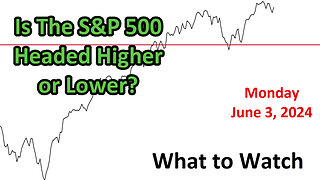The Best Stock Tip You Will Ever Receive!
My Exclusive Free Workshop The Four P's of Building a Successful Investing Program → https://spxinvesting.mailchimpsites.com
Blog: https://spxinvestingblog.com
Facebook Public Group: https://www.facebook.com/groups/433843641082343
The Best Stock Tip You Will Ever Receive!
Stock Tips
Everybody wants to know about great stocks.
I am frequently asked if I have any “inside” tips about stocks.
For many years my answer would be: “That depends.”
Over 15 years ago, I was able to change my answer to “YES.”
Very few individual investors know much, if anything, about this stock.
It’s not flashy or cool and is often overlooked or ignored.
But, if handled correctly, this is the absolute best stock in existence today.
So what is this end-all stock?
One hint: It’s NOT Bitcoin.
The answer just might surprise you.
The Best Stock in the Universe
The SPX is the very best stock I have ever found.
SPX is the S&P500.
Many new investors didn’t know such a stock even existed.
Many seasoned investors don’t take advantage of what this awesome stock has to offer.
Taking advantage of the opportunities may require many of you to think in a new way.
Isn’t the SPX a Stock Index?
Yes, it is.
But it is also a stock that can be bought and sold just like “regular” stocks.
To understand SPX stock, it is necessary to understand a little about the SPX Index.
What is The S&P500 Stock Index?
The S&P500 (often called The S&P, or SPX) is a stock market index that measures the stock performance of the 505 largest companies listed on stock exchanges in the United States.
It is one of the most commonly followed equity indices.
The SPX covers about 80 percent of the US Stock Market.
The SPX is weighted, so more valuable companies account for relatively more of the index.
When compared to other indexes (The Dow, NASDAQ, etc.), the SPX gives the most accurate representation of the current value of US companies as a whole.
The S&P500 Criteria
To qualify for being included in the SPX, a company must have:
A market capitalization of at least $8.2 billion.
Headquarters in the US.
The value of its market capitalization trade annually (liquidity).
At least a quarter-million of its shares traded in the previous six months (liquidity).
Most of its shares in the public’s hands (liquidity).
Been at least a year since its Initial Public Offering (IPO).
The sum of the previous four quarters of earnings that are positive as well as the most recent quarter.
Companies that do not meet this set of criteria are removed from the SPX Index.
Other companies that do meet these criteria are added to the SPX Index. This is built-in quality.
Where is the stock?
In the 1970s, a man named John Bogle came up with the idea of creating mutual funds that own the same stocks as the SPX.
This became very popular and is now known as Index Fund Investing.
In 1993, another idea was to create shares of stock that are made up of the SPX.
This has become even more popular and is known as an Exchange Traded Fund (ETF).
ETFs can be traded while the stock market is open.
Most mutual funds can only be “traded” when the market is closed.
The SPX ETF is the SPY
The SPY has become the most heavily traded stock in existence.
Since the average volume is so high, this allows for excellent liquidity.
Liquidity allows for numerous strategies to be used.
SPX Strategies
Very conservative to very risky, and anywhere in between. Risk versus reward.
Tailored to multiple time frames: short-term, intermediate-term, long-term.
Used to take advantage of current market conditions: up, down, sideways.
Varied according to a desire for capital gains, protection, income generation.
Simple to complicated.
One Size Fits All
The SPX has something for everyone.
Each individual investor can:
Develop a strategy that works best for them.
Allow for flexibility.
Implement multiple strategies at the same time.
No stock selection is needed because the SPX Index is maintained with quality stocks on our behalf.
New instruments that are directly tied to the SPX are being developed continuously and used.
Knowing What To Do and When To Do It
Each day, week, and month, in addition to watching, listening, and reading about what is happening, I look at over 300 points of data.
These data points are charts.
The charts tell me, either directly or indirectly, what the SPX is likely to do the next day, week, month, and even year.
This is a skill I have spent over 25 years developing. I continue to develop it each day.
Teaching others to develop this skill for themselves has become my calling in life and is my true passion.
-
 44:44
44:44
The SPX Investing Program
6 hours agoS&P 500 What to Watch for Tuesday June 3, 2024
291 -
 4:45
4:45
BrotherPaul777
2 years ago🚨WARNING🚨--BILLIONS will not ever receive and understand this message.
68 -
 46:57
46:57
Crime Circus
1 day agoApple River ST*BBING!! Stand Your Ground Interrogation of Man in Wisconsin
62.6K45 -
 9:39
9:39
Tactical Advisor
1 day agoHow To Improve Your Shooting For FREE! Mantis Blackbeard X
86.6K14 -
 1:00:59
1:00:59
Squaring The Circle w/ Randall Carlson
1 day ago#007 The Real Climate Crisis Noone Is Talking About and Mount Tambora Pt 2
91K26 -
 13:52
13:52
America Uncovered
1 day agoEveryone is WRONG About Trump's Guilty Verdict
70.1K147 -
 13:10
13:10
Censored TV
1 day agoThe Owen Benjamin vs Jim Goad debate was WILD
71.3K52 -
 25:27
25:27
Degenerate Plays
22 hours agoThe Microtransaction Master - Call Of Duty Modern Warfare Remastered : Part 3
63.1K5 -
 21:03
21:03
MYLUNCHBREAK CHANNEL PAGE
1 day agoOld World Minnesota?
69.6K38 -
 5:49:05
5:49:05
Akademiks
1 day agoDrake Next Move - Whats next?? Did Lil Baby Listen to Me? Diddy and Family Preparing for Indictment?
127K59